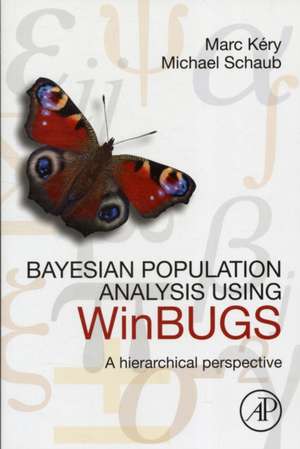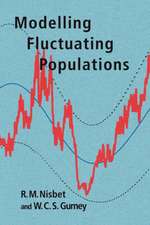Bayesian Population Analysis using WinBUGS: A Hierarchical Perspective
Autor Marc Kéry, Michael Schauben Limba Engleză Paperback – 10 oct 2011
- Comprehensive and richly commented examples illustrate a wide range of models that are most relevant to the research of a modern population ecologist
- All WinBUGS/OpenBUGS analyses are completely integrated in software R
- Includes complete documentation of all R and WinBUGS code required to conduct analyses and shows all the necessary steps from having the data in a text file out of Excel to interpreting and processing the output from WinBUGS in R
Preț: 355.70 lei
Preț vechi: 429.79 lei
-17% Nou
Puncte Express: 534
Preț estimativ în valută:
68.06€ • 70.22$ • 56.80£
68.06€ • 70.22$ • 56.80£
Carte tipărită la comandă
Livrare economică 19 martie-02 aprilie
Preluare comenzi: 021 569.72.76
Specificații
ISBN-13: 9780123870209
ISBN-10: 0123870208
Pagini: 554
Dimensiuni: 152 x 229 x 25 mm
Greutate: 0.84 kg
Editura: Elsevier
ISBN-10: 0123870208
Pagini: 554
Dimensiuni: 152 x 229 x 25 mm
Greutate: 0.84 kg
Editura: Elsevier
Public țintă
Professional ecologists, upper-level graduate and graduate ecology students.Cuprins
1. Introduction
2. Very brief introduction to Bayesian statistical modeling
3. Introduction to the generalized linear model (GLM): The simplest model for count data
4. Introduction to random effects: The conventional Poisson GLMM for count data
5. State-space models
6. Estimation of population size
7. Estimation of survival probabilities using capture-recapture data
8. Estimation of survival probabilities using mark-recovery data
9. Multistate capture-recapture models
10. Estimation of survival and recruitment using the Jolly-Seber model
11. Integrated population models
12. Metapopulation modeling of abundance using hierarchical Poisson regression
13. Metapopulation modeling of species distributions using hierarchical logistic regression
14. Concluding remarks
2. Very brief introduction to Bayesian statistical modeling
3. Introduction to the generalized linear model (GLM): The simplest model for count data
4. Introduction to random effects: The conventional Poisson GLMM for count data
5. State-space models
6. Estimation of population size
7. Estimation of survival probabilities using capture-recapture data
8. Estimation of survival probabilities using mark-recovery data
9. Multistate capture-recapture models
10. Estimation of survival and recruitment using the Jolly-Seber model
11. Integrated population models
12. Metapopulation modeling of abundance using hierarchical Poisson regression
13. Metapopulation modeling of species distributions using hierarchical logistic regression
14. Concluding remarks














